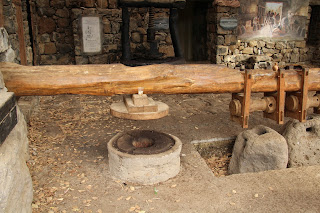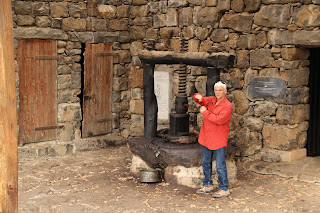Our sixth day was mixed between some of the most amazing and significant Biblical sites combined with points of understanding and history of modern Israel. Before we did any touring, we practiced the 11th commandment (Thou shalt support the economy of Israel). We stopped at a kibbutz called Naot Mordecai. This is the factory for Naot shoes.
Now, the Biblical sites. There is a niche of property carved out and claimed by the tribe of Dan in the northern part of Israel far away from the piece of ground given them in the allotments by Moses. In Dan (formerly known as Laish), we found the ruins of the gate from the time of Jeroboam. After Solomon's son Rehoboam took bad advice, Jeroboam led a revolt that broke the nation into two parts, the northern nation of Israel (10 tribes) and the southern nation of Judah (2 tribes). Jeroboam did not want the people to return to Jerusalem to worship so he created a new worship center here, with an altar like the one at the Temple. But his "temple" was worshipping two golden calves. On the eastern side of the tel of Dan, a gate was found dating to the time of Abraham. And the Scriptures say that when Abraham was chasing the kings who kidnapped Lot and his family, they came to Dan. Standing in front of the Abrahamic gate, one can look over your shoulder and see Nimrod's castle, an Ottoman era fortress. So in sight at one location you have a over 3000 years of history represented. We also stood on the Lebanese border with entrenchments in front of us.
We then made our way to Banias or Caesarea Philippi. This pagan city was the place where Peter made his profession that Jesus was the Christ, the Son of the living God. It sits at the base of Mt. Hermon, and it is believed that it was up on that mountain that Jesus was transformed before His three disciples. It was also up on that mountain that Abraham received the covenant from God. Banias was a pagan worship center for the god Pan but Arabs cannot pronounce P's, therefore they called it Banias. This also is one of the headwater springs for the Jordan River.
Lunch was at a restaurant outside a Druze village. The restaurant sits on the edge of a volcano that is now filled in by a lake. Afterwards, we stopped by kibbutz El Rom. They are known for dubbing and doing subtitles for films. They show one special short film called Oz 77, live action mixed with commentary by those who lived through the extraordinary battle that lasted three days in the Valley of Tears during the Yom Kippur War in 1973. It gave us insight into the heroism of the units involved but also into the hand of God's protection and blessing over them.
From there we made a short stop above the abandoned UN outpost of Kunietra. We observed the winding Israeli/Syrian border and looked at a distance at a town currently held by rebels in the Syrian civil war. We were standing just 25 miles from Damascus.
Our last stop was at a first century Talmudic village called Qatzrin. This reconstructed village gave us insight to life then, including a home, synagogue, wheat press and olive press. The place is amazing.
During our two longer travel times Tim shared his testimony with us all. We are so grateful and honored to have him present with us.



























No comments:
Post a Comment